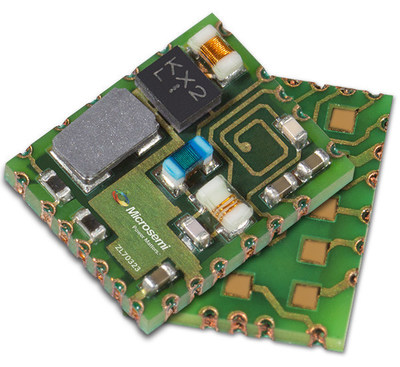Off-the-Shelf Radio Link Streamlines Product Design Efforts
ALISO VIEJO, Calif., Aug. 5, 2015 — (PRNewswire) — Microsemi Corporation (Nasdaq: MSCC), a leading provider of semiconductor solutions differentiated by power, security, reliability and performance, today announced the availability of the smallest radio module it has ever produced. The ZL70323 is optimized for implantable medical devices such as pacemakers, cardiac defibrillators and neurostimulators—measuring just 5.5mm x 4.5mm x 1.5mm. The new radio module supersedes the company's ZL70321 and complements its ZL70120 radio module used for external device controllers. Both modules are based on Microsemi's industry-leading ultralow power (ULP) ZL70103 radio transceiver chip, which supports a very high data rate radio frequency (RF) link for medical implantable communication applications.
"Our radio modules allow medical device companies to focus more of their research dollars and development efforts on new therapies that enable a better quality of life. The reduction in size makes it easier for companies to design smaller devices that aid patient comfort and reduce risk of infection, as a smaller incision is needed," said Martin McHugh, Microsemi's product line manager for the new module. "RF engineering is a highly specialized discipline and leveraging our deep expertise in this area also allows our customers to reduce design times, reduce time-to-market and minimize project risk."
RF technology is increasingly being used in a wide variety of medical implantable applications including cardiac care, physiological monitoring (e.g., insulin), pain management and obesity treatments. According to Roots Analysis Business Research & Consulting, the global neurostimulation devices market is likely to achieve sales of $6.5 billion by 2017, growing at a compounded annual growth rate (CAGR) of 17.9 percent from 2011 to 2017.
About Microsemi's Radio Link Solution
The ZL70323 implantable module implements all RF-related functions needed to deploy the implant node in a Medical Implantable Communications Service (MICS) RF telemetry system. The integrated antenna tuning circuit allows the module to be used with a wide range of implantable antennas (nominal antenna impedance is 100+j150 ohms). The module provides the following major blocks:
- ZL70103-based MICS-band RF transceiver with integrated matching network, surface acoustic wave (SAW) filter for suppression of unwanted blockers, and antenna tuning;
- 2.45 gigahertz (GHz) wake-up receiver matching network;
- Integrated 24 megahertz (MHz) reference frequency crystal; and
- Decoupling capacitors and series termination resistors.
Microsemi's ZL70103 family of products allows patient health and device performance data to be quickly transmitted with little impact to the battery life of the implanted device. The device operates in the 402–405 MHz MICS band. Multiple low power wake-up options are supported including using an ULP 2.45 GHz industrial, scientific and medical (ISM) band wake-up receive option. The ZL70103 consumes less than 6 milliamperes (mA) when transmitting or receiving and consumes only 290 nanoamperes (nA) when in a periodic sleep/sniff mode (1 second sniff interval).
Availability
Microsemi's new ZL70323 radio solution is available now. The company also offers an application development kit (ADK) to qualified customers. To learn more about Microsemi's new radio solution, visit
http://www.microsemi.com/products/ultra-low-power-wireless/implantable-medical-transceivers/zl70323 or email
Email Contact. For more information about the Microsemi's implantable and ingestible medical solutions, visit
http://www.microsemi.com/applications/medical/medical-implantable-ingestible.
About Microsemi
Microsemi Corporation (Nasdaq:
MSCC) offers a comprehensive portfolio of semiconductor and system solutions for communications, defense & security, aerospace and industrial markets. Products include high-performance and radiation-hardened analog mixed-signal integrated circuits, FPGAs, SoCs and ASICs; power management products; timing and synchronization devices and precise time solutions, setting the world's standard for time; voice processing devices; RF solutions; discrete components; security technologies and scalable anti-tamper products; Ethernet solutions; Power-over-Ethernet ICs and midspans; as well as custom design capabilities and services. Microsemi is headquartered in Aliso Viejo, Calif., and has approximately 3,600 employees globally. Learn more at
www.microsemi.com.
Microsemi and the Microsemi logo are registered trademarks or service marks of Microsemi Corporation and/or its affiliates. Third-party trademarks and service marks mentioned herein are the property of their respective owners.
"Safe Harbor" Statement under the Private Securities Litigation Reform Act of 1995: Any statements set forth in this news release that are not entirely historical and factual in nature, including without limitation statements related to the smallest radio module it has ever produced, the ZL70323, optimized for implantable medical devices such as pacemakers, cardiac defibrillators and neurostimulators, and its potential effects on future business, are forward-looking statements. These forward-looking statements are based on our current expectations and are inherently subject to risks and uncertainties that could cause actual results to differ materially from those expressed in the forward-looking statements. The potential risks and uncertainties include, but are not limited to, such factors as rapidly changing technology and product obsolescence, potential cost increases, variations in customer order preferences, weakness or competitive pricing environment of the marketplace, uncertain demand for and acceptance of the company's products, adverse circumstances in any of our end markets, results of in-process or planned development or marketing and promotional campaigns, difficulties foreseeing future demand, potential non-realization of expected orders or non-realization of backlog, product returns, product liability, and other potential unexpected business and economic conditions or adverse changes in current or expected industry conditions, difficulties and costs of protecting patents and other proprietary rights, inventory obsolescence and difficulties regarding customer qualification of products. In addition to these factors and any other factors mentioned elsewhere in this news release, the reader should refer as well to the factors, uncertainties or risks identified in the company's most recent Form 10-K and all subsequent Form 10-Q reports filed by Microsemi with the SEC. Additional risk factors may be identified from time to time in Microsemi's future filings. The forward-looking statements included in this release speak only as of the date hereof, and Microsemi does not undertake any obligation to update these forward-looking statements to reflect subsequent events or circumstances.

Photo -
http://photos.prnewswire.com/prnh/20150804/255331
Logo -
http://photos.prnewswire.com/prnh/20110909/MM66070LOGO
To view the original version on PR Newswire, visit: http://www.prnewswire.com/news-releases/microsemis-new-rf-module-speeds-time-to-market-for-implantable-medical-device-designers-300123808.html
SOURCE Microsemi Corporation
| Contact: |
| Microsemi Corporation
EDITORIAL CONTACTS: Farhad Mafie, VP Worldwide Product Marketing, 949-356-2399; Beth P. Quezada, Director, Corporate Communications, 949-380-6102, Email: Email Contact Web: http://www.microsemi.com |